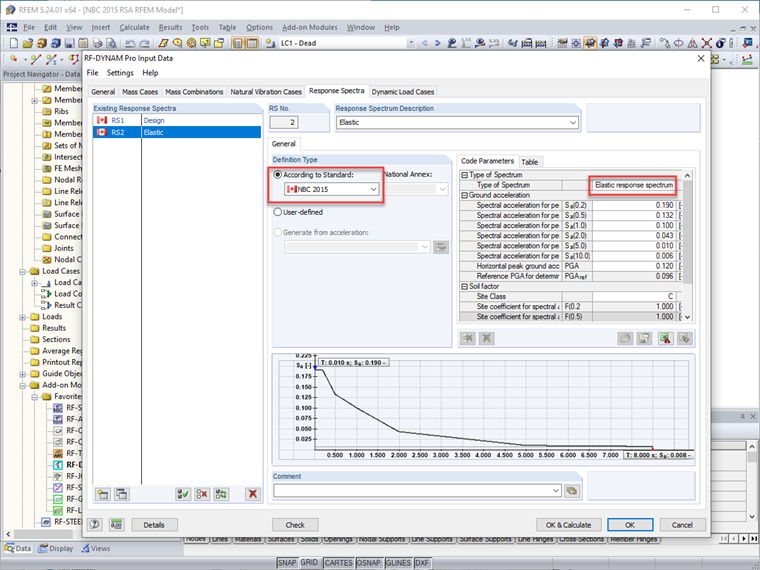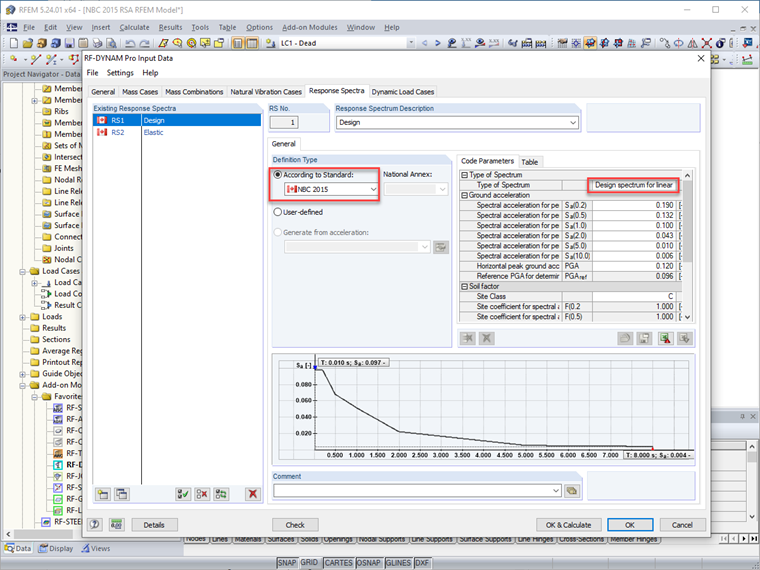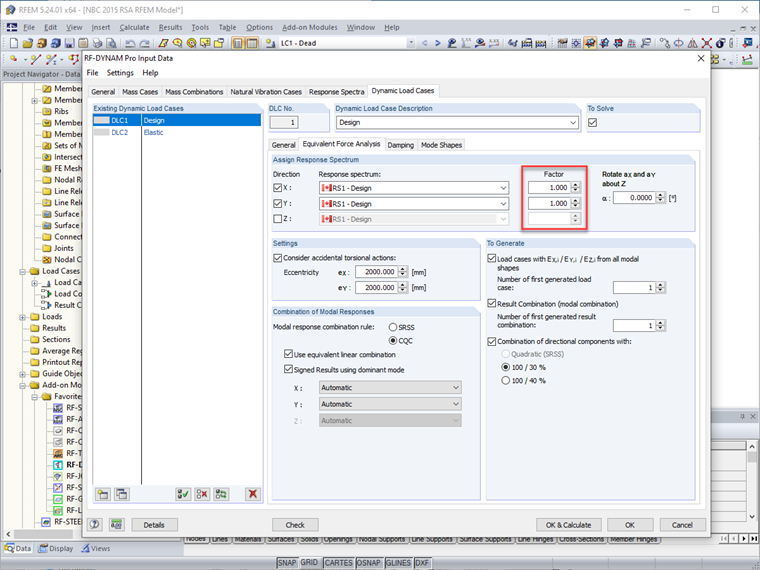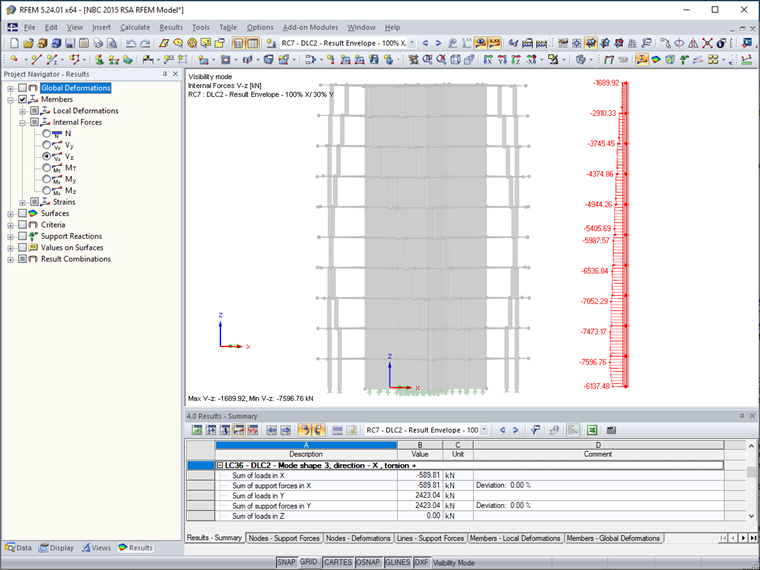For structures that qualify for the Dynamic Analysis Procedure, two further sub-methods are defined in 4.1.8.12 [1], including a Linear Dynamic Analysis, with either a Modal Response Spectrum Method, the Numerical Integration Linear Time History Method, or a Nonlinear Dynamic Analysis. This article will focus on a Modal Response Spectrum Method (RSA) and the further base shear requirements defined in NBC 2015.
NBC 2015 Base Shear Variations
Assuming that an RSA is calculated according to the NBC which is beyond the scope of this article, the base shear can be determined at the bottom story of the structure in each of the orthogonal directions in which the lateral seismic load is applied. A series of steps in Article 4.1.8.12 [1] defines the various base shear variations needed to ultimately scale the story shears, story forces, member forces, and deflection, if necessary.
Step 1)
In Sentence (5) [1], the elastic base shear, Ve, should be determined from a linear dynamic analysis, which is the first step in understanding the NBC base shear requirements. Ve should not include any additional factors or scaling applied to the response spectrum.
Step 2)
Determine the design elastic base shear, Ved, also known as the "lateral earthquake design elastic force", according to Sentence (6) [1] using Ve determined from Sentence (5) [1]. For all structures located on sites other than Class F and having a seismic force-resisting system (SFRS) with a ductility-related force modification factor, Rd, equal to or greater than 1.5, then Ve should be multiplied by the larger of the following two factors:
|
S(0.2) |
Design spectral response acceleration for a period of T = 0.2 sec |
|
S(0.5) |
Design spectral response acceleration for a period of T = 0.5 sec |
|
S(Ta) |
Design spectral response acceleration for the fundamental lateral period of vibration of the structure in the direction under consideration |
Step 3)
The previously determined Ved should be multiplied by the importance factor, Ie, given in Article 4.1.8.5 [1] and divided by the ductility-related force modification factor multiplied by the overstrength-related force modification factor, RdRo, found in Table 4.1.8.9 [1] to determine the design base shear, Vd.
Step 4)
Determine the lateral earthquake design force, V, given in Article 4.1.8.11 [1] according to the simplified ESFP.
NBC 2015 Base Shear Scaling Requirements
With the information above, in collaboration with 4.1.8.12(8) [1], if Vd from Step 3 is less than 80% of V from Step 4, then Vd should be taken as 0.8V for all regular structures and irregular structures permitted to be designed with the ESFP.
For all irregular structures which require a dynamic analysis specified in 4.1.8.7 [1], as well as wood structures greater than 4 stories which meet the criteria set forth in 4.1.8.12(12) [1], then Vd shall be taken as the larger of Vd or V stated in 4.1.8.12(9) [1].
In addition to these minimums, the scale factor Vd/Ve should be applied to story shears, story forces, member forces, and deflections, including the effects of accidental torsion to determine the design values from 4.1.8.12(10) [1].
NBC 2015 Base Shear Application in RFEM
With the multiple variations for base shear discussed in NBC 2015, it may be difficult to determine which base shear variant is provided when running a response spectrum analysis according to the standard in the structural analysis program RFEM.
In the RF-DYNAM Pro – Equivalent Loads module, two spectrum types are available after selecting NBC 2015, including the "Elastic response spectrum" and the "Design spectrum for linear calculation".
The "Elastic response spectrum" will provide the structure’s elastic base shear, Ve, from 4.1.8.12(5) [1] or Step 1 above. This value does not include the consideration of Ie/RdRo or any other factors.
The "Design spectrum for linear calculation" will provide the structure’s design base shear, Vd, from 4.1.8.12(7) [1] or Step 3 above. However, it should be noted that the additional factor specified in 4.1.8.12(6) or Step 2 above is not included in this calculation. The calculation does include Ie/RdRo, as these variables are listed in the RF-DYNAM Pro – Equivalent Loads Code Parameters table, whereas they are not listed for the "Elastic response spectrum".
For either spectrum type, the user will have the ability to scale the equivalent loads to account for scale factor requirements in the add-on module. For example, the "Elastic response spectrum", which is needed to analyze the structure deflections as it does not include the effects of Ie/RdRo, may need to be scaled by Vd/Ve as required in 4.1.8.12(10). For the "Design Spectrum for Linear Calculation" type, the Vd/Ve scale factor may also apply in addition to the factor specified in 4.1.8.12(6) or Step 2 above, which is not included in the calculation. RF-DYNAM Pro – Equivalent Loads provides a scaling option in each of the global directions X, Y, and Z, in which the seismic force can be applied.
In summary, the linear dynamic analysis requirement and, in particular, the modal response spectrum analysis set forth by NBC 2015, can be considered by utilizing the FEA program RFEM in addition to the RF-DYNAM Pro - Equivalent Loads add-on module. The many base shear variations in Article 4.1.8.12 can be calculated utilizing the program with either the spectrum type designation or the application of the scaling factor entry option in the module.



